CREATING EFFECTIVE RETAIL DISPLAYS
Master the Art of Retail Merchandising
In today's competitive retail landscape, the difference between a browsing customer and a buying one often comes down to how effectively your products are displayed. With over 55 years of experience crafting custom retail displays, Bull Display Products understands that successful merchandising requires strategic planning, creative design, and attention to detail.
This comprehensive guide will walk you through proven strategies to create compelling product displays that not only attract attention but drive sales and enhance customer experience.
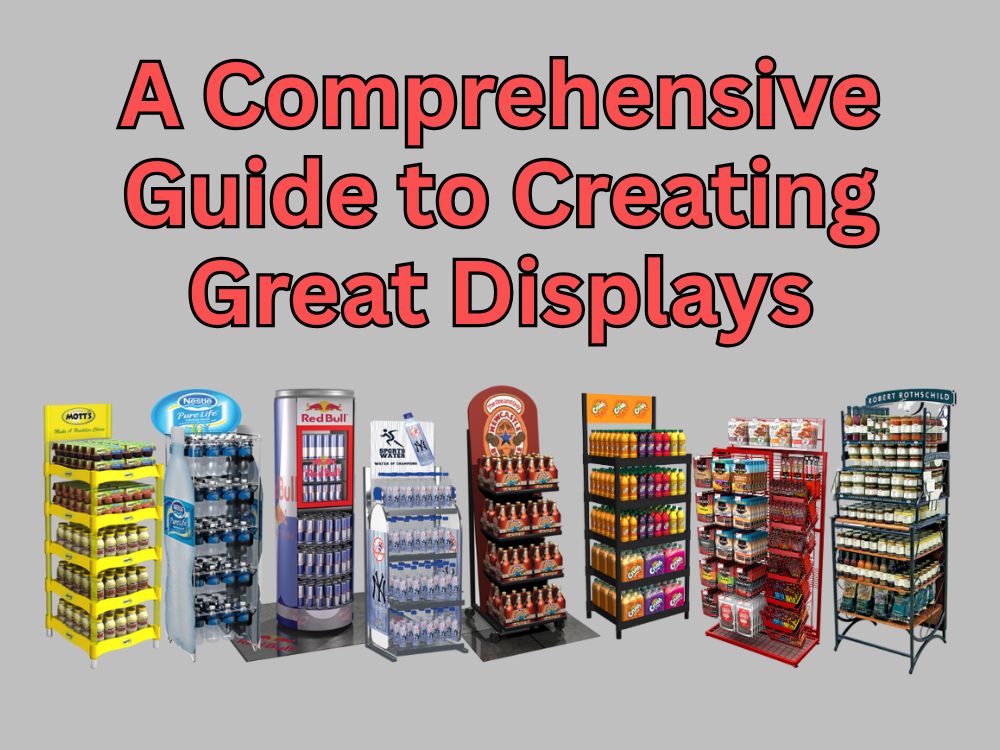
Strategic Height and Placement
The strategic placement of your display can significantly impact customer engagement and product visibility. Research shows that products positioned at eye level (between 4.5 and 5.5 feet) receive 35% more attention than those placed on lower or higher shelves.
Proven Placement Strategies:
- Position best-selling items at eye level in the "golden zone"
- Place impulse purchases near checkout areas for last-minute decisions
- Create clear sight lines that guide customers through your entire display
- Ensure accessibility from multiple angles to maximize visibility
- Use tiered displays to maximize vertical space while maintaining visibility
Advanced Placement Techniques:
- Implement the "rule of thirds" to create balanced, visually appealing layouts
- Position complementary products adjacently to encourage multiple purchases
- Create "disruption zones" that break expected patterns to catch attention
- Utilize "hot spots" near entrances and main walkways for featured items
- Consider traffic flow patterns when determining optimal display locations
Pro Tip: Regularly rotate product positions to keep displays fresh and expose customers to different merchandise. Studies show that changing display layouts every 2-4 weeks can increase sales by up to 25%.
The Power of Visual Hierarchy
Visual hierarchy is the arrangement of elements in a way that indicates importance, with more prominent items attracting attention first. A well-designed display naturally guides the customer's eye through your products in a strategic sequence.
By understanding how customers visually process displays, you can create arrangements that highlight key products and tell a cohesive brand story.
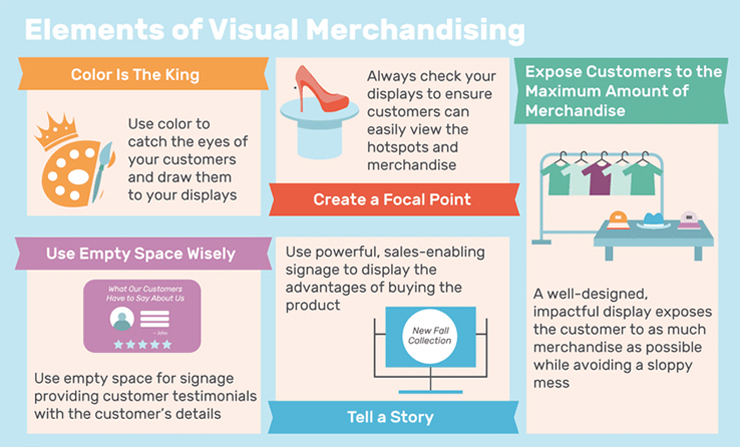
Key Visual Hierarchy Principles
Create a Focal Point
Establish a main focal area using your bestselling or featured items. This anchor point draws customers in and serves as the starting point for their visual journey.
Arrange by Importance
Position products in descending order of importance, with primary items at eye level, secondary items above, and tertiary items below to create a natural visual flow.
Size and Contrast
Use variations in size, color, and empty space to create contrast and visual interest. Larger items naturally draw more attention and can anchor your display.
Utilize Negative Space
Incorporate empty areas around key products to prevent visual clutter and help important items stand out. Crowded displays can overwhelm customers and reduce impact.
Group Complementary Items
Create logical groupings of related products to encourage multiple purchases and provide context for how items can be used together in solutions.
Follow Reading Patterns
Arrange products to align with natural reading patterns (left to right, top to bottom in Western cultures) to create intuitive navigation through your display.
Color Psychology and Lighting Strategies
The strategic use of color and lighting can significantly impact customer perception and behavior. Different colors evoke specific emotions and associations, while effective lighting can transform the appearance and appeal of your products.
Research shows that shoppers make subconscious judgments about products within 90 seconds of initial viewing, and between 62-90% of that assessment is based on color alone.
Strategic Color Implementation
- Use contrasting colors to create visual pop and draw attention to key products
- Incorporate brand colors thoughtfully to strengthen identity and recognition
- Consider color psychology:
- Red: Excitement, urgency, impulse purchases
- Blue: Trust, reliability, quality
- Green: Health, freshness, environmental consciousness
- Black: Luxury, sophistication, premium quality
- Yellow: Optimism, clarity, attention-grabbing
- Implement color zoning to differentiate product categories and guide navigation
- Account for color harmony to create pleasing, cohesive displays that don't overwhelm
Effective Lighting Techniques
- Ensure proper illumination to highlight product details and quality
- Consider color temperature:
- Warm lighting (2700-3000K): Creates intimate, cozy atmosphere
- Natural lighting (3500-4100K): Provides balanced, neutral presentation
- Cool lighting (5000-6500K): Conveys clean, modern, energetic feeling
- Use spotlighting to draw attention to featured items and create visual interest
- Account for ambient lighting when designing displays for specific retail environments
- Consider dynamic lighting that changes throughout the day or responds to customer interaction
- Implement backlighting for dramatic effect and enhanced visibility
Case Study: A retail client partnering with Bull Display saw a 32% increase in sales after implementing a strategic lighting redesign that used warm spotlights to highlight their premium products while cooler ambient lighting was used throughout the store.
Material Selection for Maximum Impact
The materials used in your display communicate subtle but powerful messages about your brand and products. From premium wood finishes to sleek metals or modern acrylics, your material choices should align with your brand identity and product positioning.
At Bull Display, we work with a wide range of materials including wire, tubing, sheet metal, stainless steel, aluminum, various plastics, vacuum forming, hardwoods, melamine, and more – each offering unique benefits and aesthetic qualities.
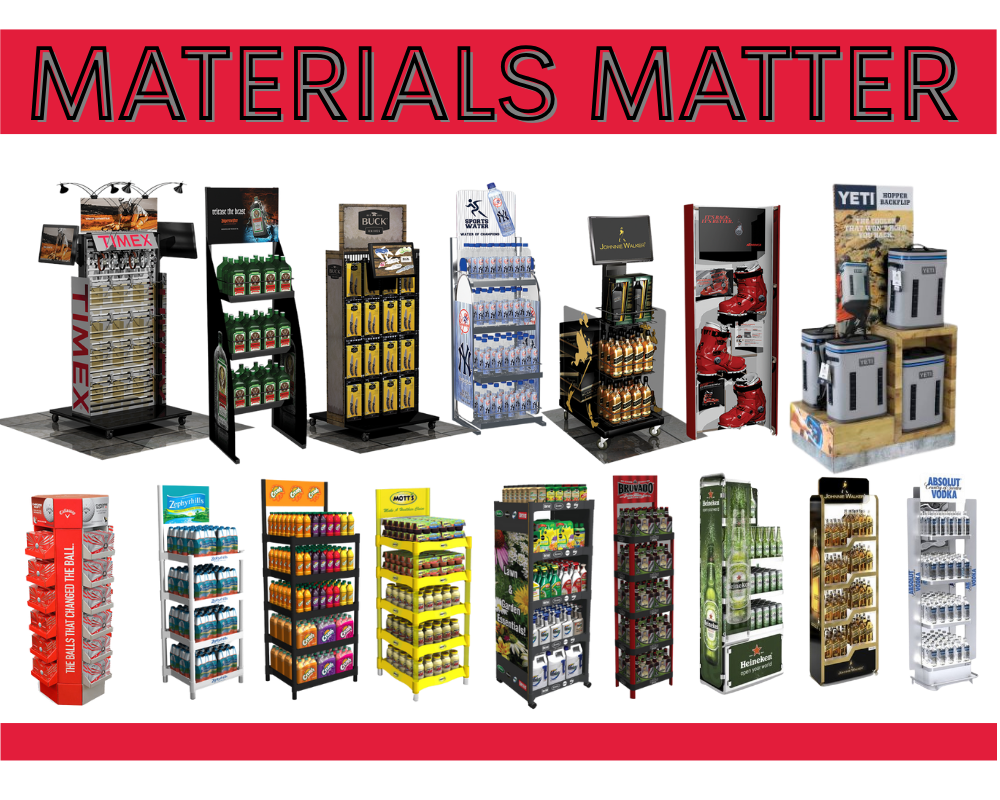
Strategic Material Considerations
Brand Alignment
Select materials that reflect your brand quality and values. Premium brands might opt for glass, hardwood, or brushed metals, while eco-conscious brands might emphasize sustainable materials like bamboo or recycled components.
Durability Requirements
Consider the retail environment and expected lifespan of your display. High-traffic areas require more durable materials like metal or high-grade plastics, while temporary promotional displays might use more economical options.
Product Compatibility
Choose materials that complement your products without overshadowing them. The display should enhance product perception while providing appropriate support for weight, size, and special requirements.
Adaptability
Consider materials that allow for reconfiguration or customization as your product line evolves. Modular systems using compatible materials provide flexibility for future display needs.
Maintenance Requirements
Select materials that are easy to clean and maintain in retail environments. Some materials may require special care, while others offer convenient maintenance that saves time and resources.
Budget Considerations
Balance material quality with budget constraints. Often, strategic material combinations can achieve a premium look while remaining cost-effective. We can help identify the best options for your specific needs.
Best Practices for Product Organization
Even the most beautiful display will underperform if products aren't organized thoughtfully. Strategic organization not only improves the aesthetic appeal of your display but also enhances customer navigation and product findability.
Effective organization creates logical product groupings that make sense to customers and encourages additional purchases by highlighting complementary items and solutions.
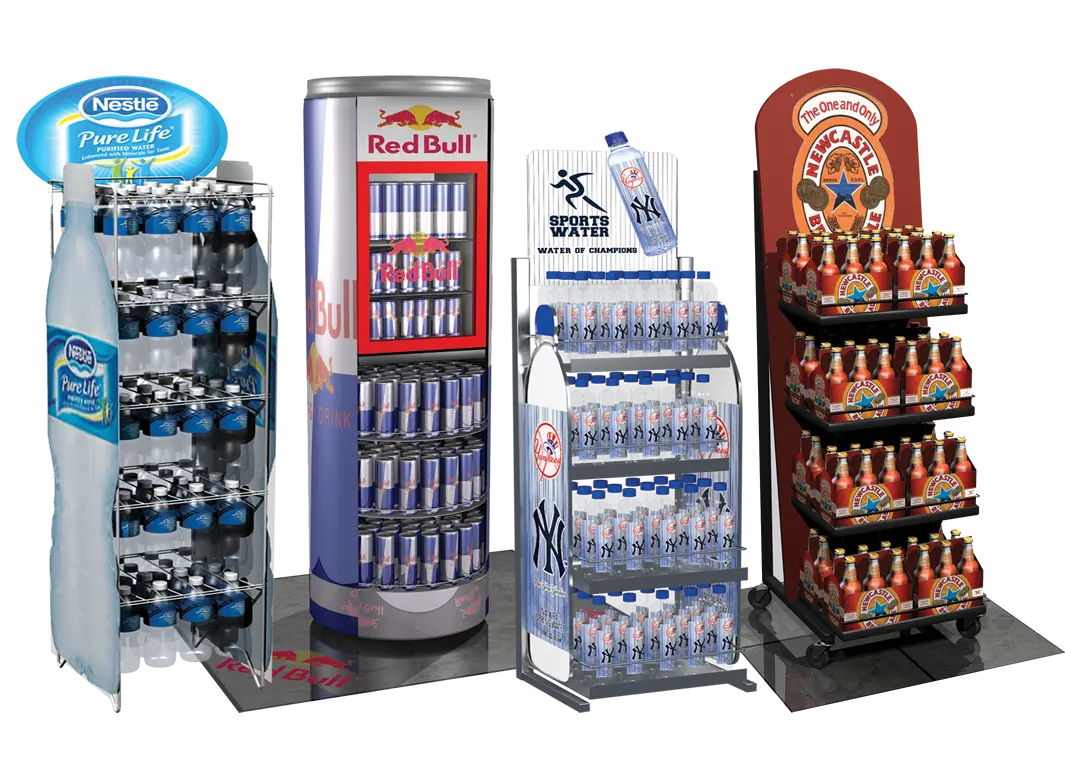
Organizational Principles
- Create clean, uncluttered arrangements that allow products to breathe and be viewed individually
- Implement consistent spacing between items to create visual harmony and improve scanability
- Develop logical product groupings based on category, use case, color, or price point
- Use storytelling arrangements that walk customers through product uses or collections
- Create balanced asymmetry to add visual interest while maintaining organization
Maintenance Strategies
- Rotate stock regularly to ensure freshness and prevent product deterioration
- Establish regular restocking protocols to maintain fully stocked displays at all times
- Implement quick recovery systems for straightening and realigning products throughout the day
- Create clear merchandising guidelines for staff to ensure consistent presentation
- Schedule periodic deep cleaning to maintain display appearance and product appeal
Advanced Tip: Cross-merchandising strategically placed complementary products can increase average transaction value by 18-30%. For example, placing compatible accessories near main products or creating complete solution displays that show items working together.
Measuring Display Effectiveness
To optimize your retail displays over time, it's essential to implement metrics that track performance and provide actionable insights. By analyzing both quantitative data and qualitative feedback, you can continuously refine your display strategies for maximum impact.
Sales
Metrics
Engagement Metrics
Feedback Metrics
Data-Driven Decision Making: Establish a regular review schedule for display performance data. Analyze metrics monthly to identify trends and opportunities for improvement. Use this information to make informed decisions about future display designs, placements, and product selections.
Industry-Specific Display Considerations
Beverage & Food
Refrigerated displays with temperature control, hygienic materials for food safety, and strategic placement near complementary items to encourage meal solutions.
Learn MoreSporting Goods
Durable displays that allow hands-on interaction with equipment, lifestyle imagery that inspires activity, and informative elements highlighting technical features.
Learn MoreAutomotive
Heavy-duty materials for substantial products, educational components that clarify compatibility, and organization systems that facilitate easy part identification.
Learn MoreJewelry & Accessories
Secure displays with premium materials, specialized lighting that enhances sparkle and shine, and anti-theft features that still allow product visibility.
Learn MoreElectronics
Interactive displays that demonstrate functionality, secure fixtures that prevent theft while allowing testing, and clean designs that highlight technological innovation.
Learn MoreHome Improvement
Robust displays for heavy tools and materials, educational components that show installation processes, and solution-based presentations for DIY projects.
Learn MoreThe Bull Display Products Advantage
For over 55 years, Bull Display Products has been crafting custom retail displays that drive sales and enhance brand presence. Our team of design experts works closely with clients to create displays that incorporate industry best practices while meeting specific business needs.
When you partner with Bull Display, you benefit from decades of manufacturing experience, creative design expertise, and deep understanding of retail environments across multiple industries.
Our Comprehensive Services Include:
- Collaborative design consultations
- Custom display manufacturing
- Premium material selection
- Professional installation support
- Ongoing maintenance guidance
- Flexible solutions for any retail environment
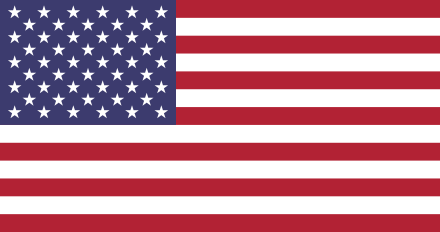
Made in the USA: All our displays are proudly designed and manufactured in our Middletown, Connecticut facility, ensuring superior quality control and supporting American jobs.
Client Success Story
"Working with Bull Display transformed our retail presentation. Their team designed custom floor displays that showcased our automotive products perfectly. Since implementation, we've seen a 27% increase in sales for featured items and received overwhelmingly positive feedback from both customers and staff. Their attention to detail and quality craftsmanship is evident in every aspect of our displays."
— Automotive Parts Manufacturer, National Retail Chain
Ready to Transform Your Retail Displays?
Contact our team today to discuss how we can help you create the perfect display solution for your products.
REQUEST A QUOTE